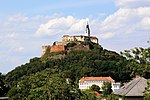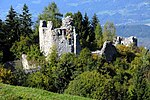Schloss Seggau
- View a machine-translated version of the German article.
- Machine translation, like DeepL or Google Translate, is a useful starting point for translations, but translators must revise errors as necessary and confirm that the translation is accurate, rather than simply copy-pasting machine-translated text into the English Wikipedia.
- Do not translate text that appears unreliable or low-quality. If possible, verify the text with references provided in the foreign-language article.
- You must provide copyright attribution in the edit summary accompanying your translation by providing an interlanguage link to the source of your translation. A model attribution edit summary is
Content in this edit is translated from the existing German Wikipedia article at [[:de:Schloss Seggau]]; see its history for attribution. - You may also add the template
{{Translated|de|Schloss Seggau}}to the talk page. - For more guidance, see Wikipedia:Translation.
| Schloss Seggau | |
|---|---|
| Styria, Austria | |
 | |
| Type | Castle |
| Site information | |
| Open to the public | Hotel (seminars and conferences) and the "Schloss Café" |
| Site history | |
| Built | 12th century |
| Built by | Archbishopric of Salzburg |

Schloss Seggau is a castle situated in the locality Seggauberg in southern Styria, Austria. It is located on a wooded hill overlooking the town of Leibnitz. Schloss Seggau is situated at a height of 344 metres (1,129 ft).[1]
History
The area around Schloss Seggau has been settled since at least the Roman era, as demonstrated by the impressive lapidarium which has survived from that period. The upper castle was built by the Archbishopric of Salzburg in the twelfth century as a base for missions and supervision and this original structure was expanded in 1218 by the bishops of Seckau. Over time, a total of three castles were built: Burg Leibnitz (belonging to the Archbishopric of Salzburg), the castle of the bishops of Seckau, and Schloss Polheim. The castles were completed in their present form under Bishop Johann Ernst, Count of Thun, in the latter half of the seventeenth century. Schloss Seggau was the residence of the bishops until 1786, after which it remained their summer residence until into the twentieth century.
Schloss Seggau now serves as a site for seminars and conferences with a hotel and a "Schloss Cafe". The wine cellar is over three hundred years old and offers the opportunity for wine tastings and sales.
See also
References
- ^ Schloss Seggau Height and Position
External links
- Schloss Seggau - official website
Burgenland 






Carinthia Lower Austria Salzburg Styria Tyrol Upper Austria Vorarlberg
 | This Styria location article is a stub. You can help Wikipedia by expanding it. |
- v
- t
- e
  | This article about a castle in Austria is a stub. You can help Wikipedia by expanding it. |
- v
- t
- e












